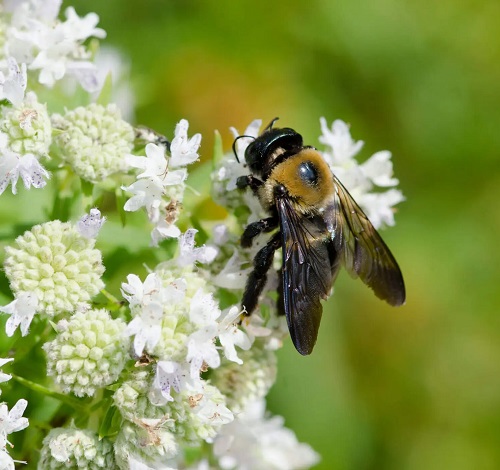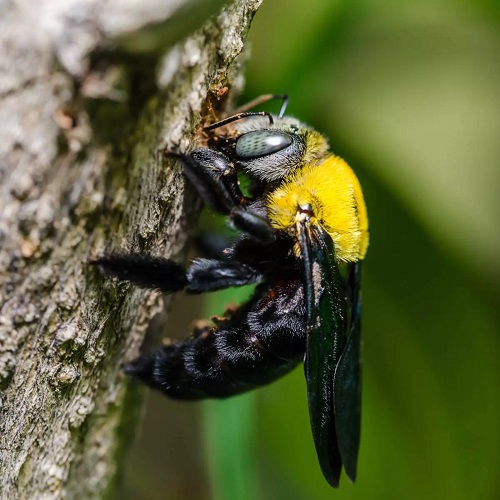Here is our detailed Carpenter Bee vs Bumble Bee guide that will tell you all the differences and even similarities!
Buzzing through gardens and hovering around wooden structures, both carpenter bees and bumblebees are familiar sights in outdoor spaces. But did you know these buzzing insects are often mistaken for each other, despite having strikingly different habits, nesting preferences, and roles in our ecosystem? Dive in to discover the captivating world of these bees with our detailed Carpenter Bee vs Bumble Bee guide!
Leafcutter Bees: Are they Good or Bad | Do Leafcutter Bees Sting
Carpenter Bee
Carpenter bees belong to the Xylocopa genus and are known for their wood-boring behavior. They are solitary bees that make their nests by drilling holes in wood. They prefer to nest in dead wood, but they can also drill holes in live wood, which can weaken the structure of the wood over time.
Carpenter bees are usually around 1 inch long and have a shiny black abdomen. The males are often more aggressive than the females and can be seen hovering around the nest entrance, ready to defend it from any perceived threat.
Read about 46 Best Plants that Attract Bees here
Bumble Bee
Bumble bees belong to the Bombus genus and are known for their fuzzy appearance and gentle nature. They are social bees that live in colonies, with a queen and several worker bees.
Bumble bees nest in the ground, under piles of leaves, or in abandoned rodent burrows. They are usually larger than Carpenter bees, with an average length of 1.3 inches. Bumble bees are black and yellow, with a fuzzy abdomen that can range in color from yellow to orange.
Do Bumble Bees Sting? Find Out!
Carpenter Bee vs Bumble Bee
1. Appearance:
- Carpenter Bees: These bees are usually about 1 inch in size. They have a shiny, black abdomen and may have yellow or white hairs on the thorax. The males of some species can be golden or greenish. Their most distinguishing feature is their relatively hairless, glossy and metallic-looking abdomen.
- Bumblebees: Bumblebees are roughly the same size as carpenter bees, but their bodies, including the abdomen, are completely covered in dense hair, often banded black and yellow, which gives them a fuzzy appearance.
2. Behavior:
- Carpenter Bees: Carpenter bees are solitary insects. Females burrow into wood to lay their eggs, creating tunnels that can damage wooden structures. They do not live in colonies and do not produce honey. Male carpenter bees can be territorial and may hover in front of people who approach their nests, but they do not have stingers and are harmless. Females can sting but usually only do so if handled or provoked.
- Bumblebees: Bumblebees are social insects that live in colonies. They build nests in the ground, often in abandoned rodent burrows or under piles of grass clippings or leaves. They do produce a small amount of honey-like substance, but it’s not harvested by humans. Bumblebees are generally not aggressive and prefer to flee to avoid confrontation. However, they can sting if they feel threatened, and unlike honeybees, they can sting more than once.
Do carpenter bees Sting? Find out here
3. Flight Pattern:
- Carpenter Bees: Carpenter bees have a rather erratic, darting flight pattern. They can hover in one place, move suddenly to a new location, and then hover again, making them seem unpredictable.
- Bumblebees: Bumblebees tend to have a more consistent and less erratic flight pattern as they move from flower to flower. Their flight is slow and somewhat bumbling, which is how they got their name.
4. Pollination:
- Carpenter Bees: Carpenter bees are important pollinators, especially of open-faced flowers. However, they are also known for “nectar robbing,” which is when they cut into the sides of flowers to reach the nectar without pollinating the flower.
- Bumblebees: Bumblebees are very effective pollinators for many types of flowers. They employ a technique called “buzz pollination,” in which the bee grabs onto a flower’s stamen and vibrates its flight muscles rapidly, dislodging pollen that other bees and insects can’t reach.
Carpenter Bee vs Bumble Bee – Similarities
1. Appearance:
- Size: Both carpenter bees and bumblebees are larger than many other types of bees. They can be similar in size, often around an inch in length, which is larger than honeybees.
- Coloring: They both often have black and yellow coloring, which can lead to them being mistaken for each other. They both typically have yellow or white hairs on their thorax.
2. Role in the Ecosystem:
Both carpenter bees and bumblebees play a crucial role in pollinating plants. While they go about pollination in different ways (carpenter bees sometimes “rob” nectar without pollinating, while bumblebees use a method known as “buzz pollination”), they both contribute significantly to helping plants reproduce.
Find How to Attract Bees to Your Garden here
3. Diets:
Both carpenter bees and bumblebees feed on nectar and pollen from flowers. The females of both species collect pollen to feed their larvae.
4. Seasonality:
Both types of bees are most commonly seen in the spring and summer when the weather is warmer and flowering plants are abundant.
5. Ability to Sting:
In both species, the females have the ability to sting. Male carpenter bees and bumblebees do not have stingers and cannot sting.





